Honda Metropolitans + Ruckuses, Impaktech Crash Cage Install, ZX7R Street Bike, Racing Recaps – MRA Round 4 Endurance @ HPR Full Course and Round 5 @ PMP
Common Motoring Machines
Honda Mets and Ruckuses are common scooters for uncommon people; everyone I meet with a scooter always seems like their own kind of person. Sure I can split y’all into groups, but every one of you down to the individual always has something different going on, and meeting you is one of the coolest parts of my job.
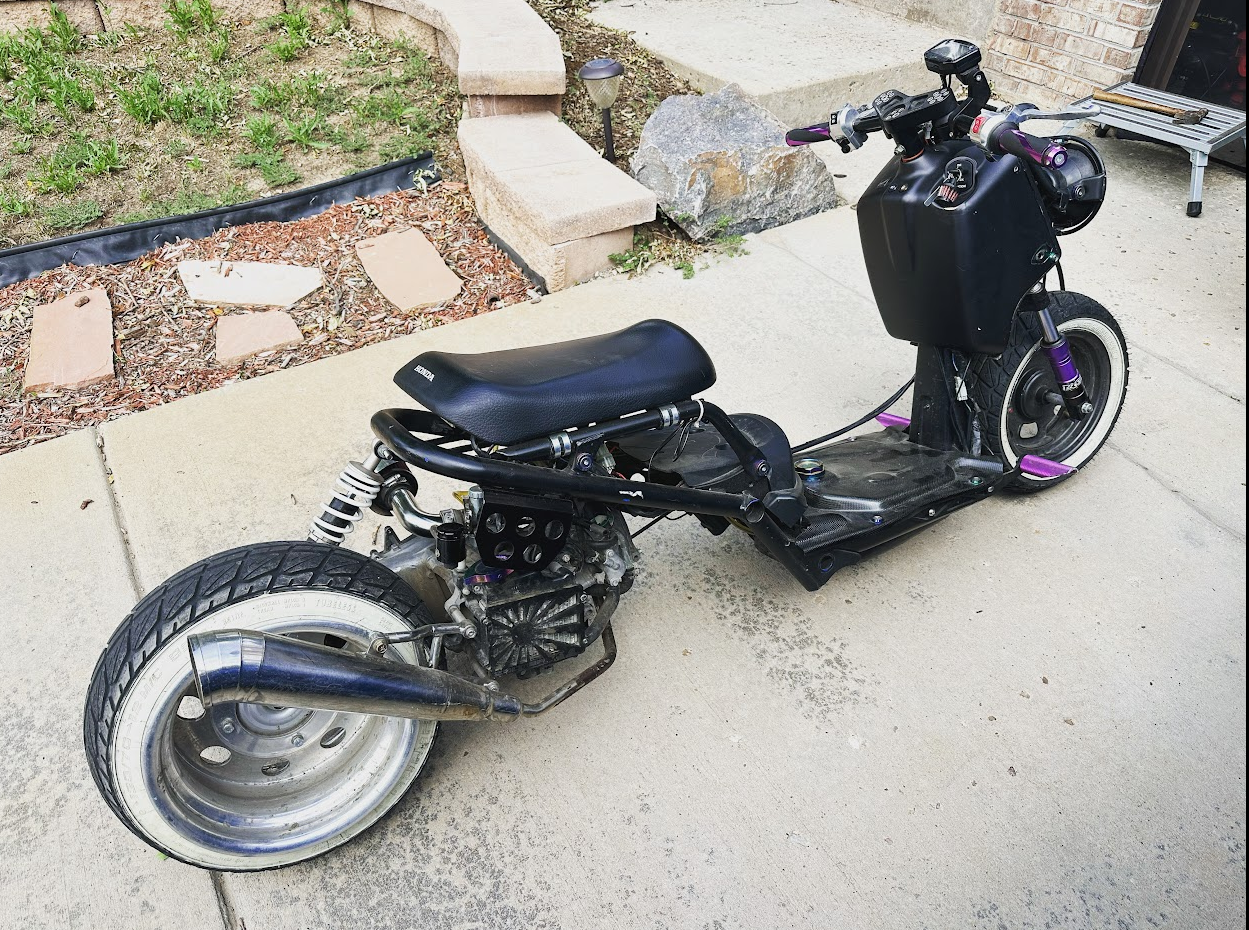
This stretched, blinged-out-with-parts-from-pep-boys Ruckus was in a state when I first saw it, but I got it back to running, so the current owner could sell it on to a friend of his. It would have taken a lot more work to make it really good, and even then it would still be slower and handle worse than a stock Honda Ruckus. I call this a “tuition bike”, which is when someone wants to modify a motorbike, so they buy something and proceed to kind of ruin it. I don’t mean this as a put down. I’ve been there; if only I could show you some of the stuff I put together as a teenager. Our hearts are in the right places. It’s a good thing universal pocket computers with built in digital cameras weren’t a thing back then.
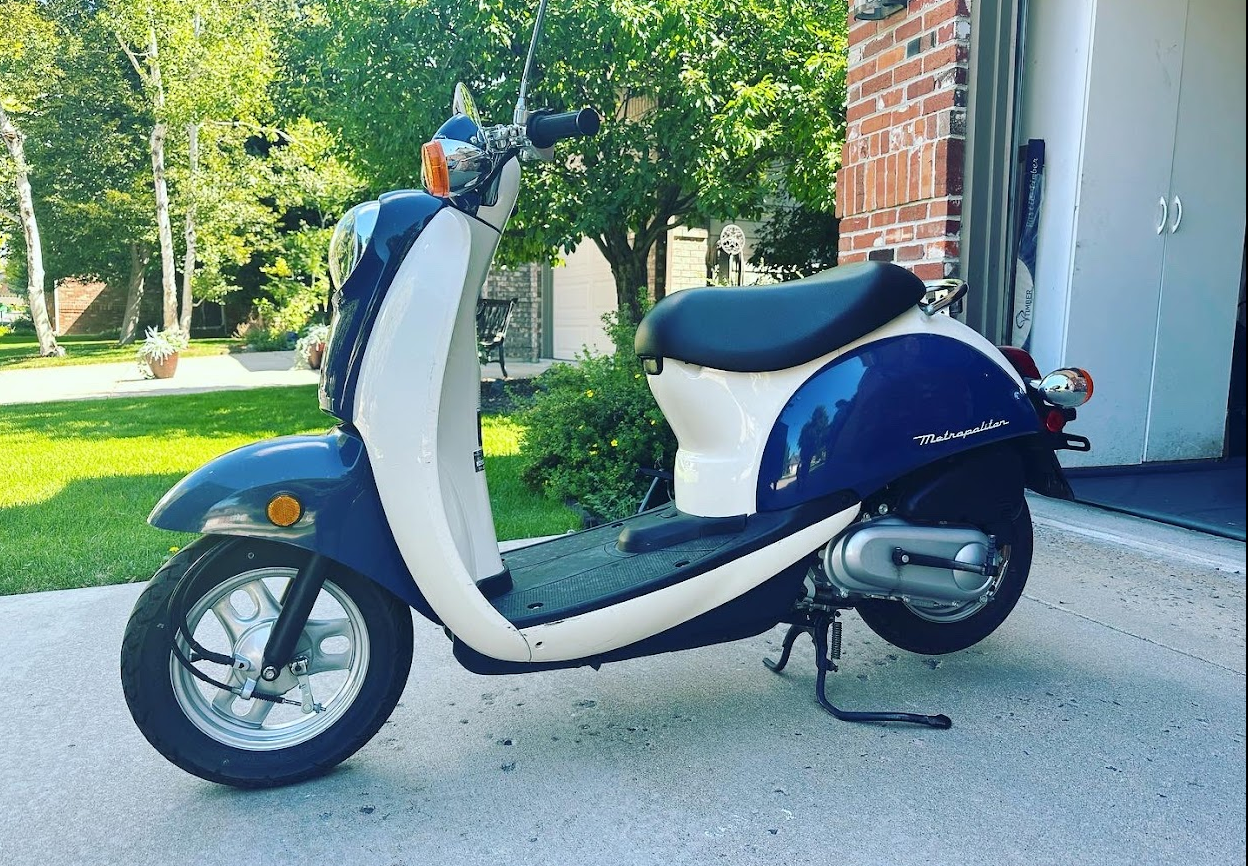
One of many low-miles, super clean, nearly 20-year-old Honda Metropolitans I’ve worked on. This one had about 300 miles on it. Owing to their complexity (for a scooter), these bikes are sometimes expensive to repair. Maintenance is as simple as changing the oil, keeping air in the tires, and occasionally replacing the spark plug and air filter. However, when they sit for a long time, they often need their fuel pumps, filters, and tanks replaced. That’s $200+ in parts alone.
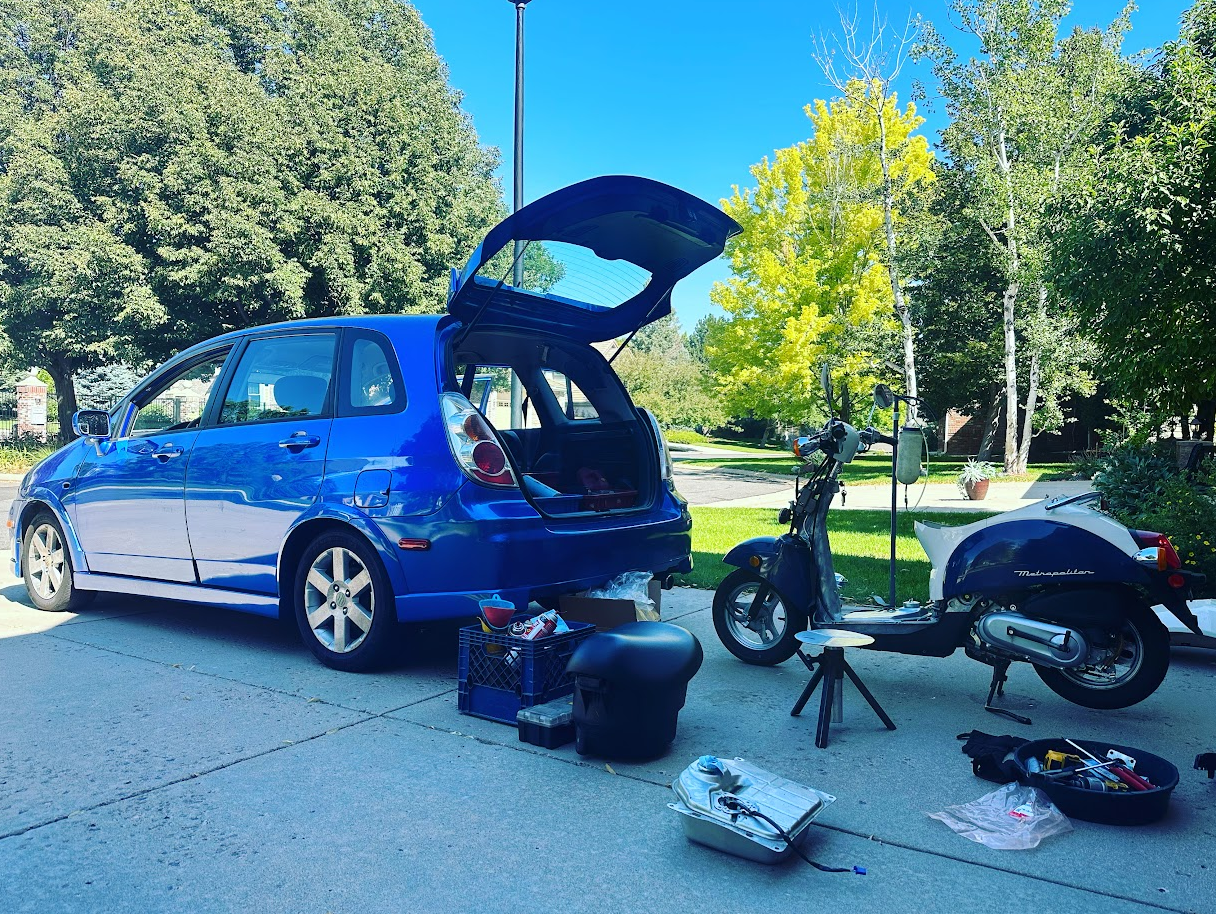
They represent good value when bought and sold used. If you have no interest in going fast on a scooter, it’s one of the best scooters money can buy. Just watch for rust in the fuel tank and try not to let the one you buy sit for too long. $1200-1500 is a good price to pay or get for a used, low-mileage (under 5k) Honda Met here in Colorado.
The little blue car is my new service vehicle, an ’05 Suzuki Aerio SX with an automatic transmission and AWD with 102k miles on it. Like my old Smart Fortwo, it’s kind of shaped like a scooter. I’ve always had a thing for quirky hatchbacks and wagons. After looking at 2-3 small trucks in the $4-5k range, all of them with rust issues, leaking at least 2 types of vital fluids, with doors and tailgates that didn’t open or close properly, I fell in love when I saw this car on Craigslist.
The seats fold down, and there’s more room inside than there was in my Smart car. It doesn’t leak anything, which is important when I’m constantly parking on pristine driveways. And it cost me a third to a quarter of what a truck in similar condition would have cost. I’ve put about 500 miles on it so far, and it hasn’t missed a beat. And no, it’s not a Chevy or Daewoo re-badge; it’s its own thing designed by Suzuki and made in Japan. Suzuki makes fine motorbikes and, from what I can tell so far, builds some decent cars, too.
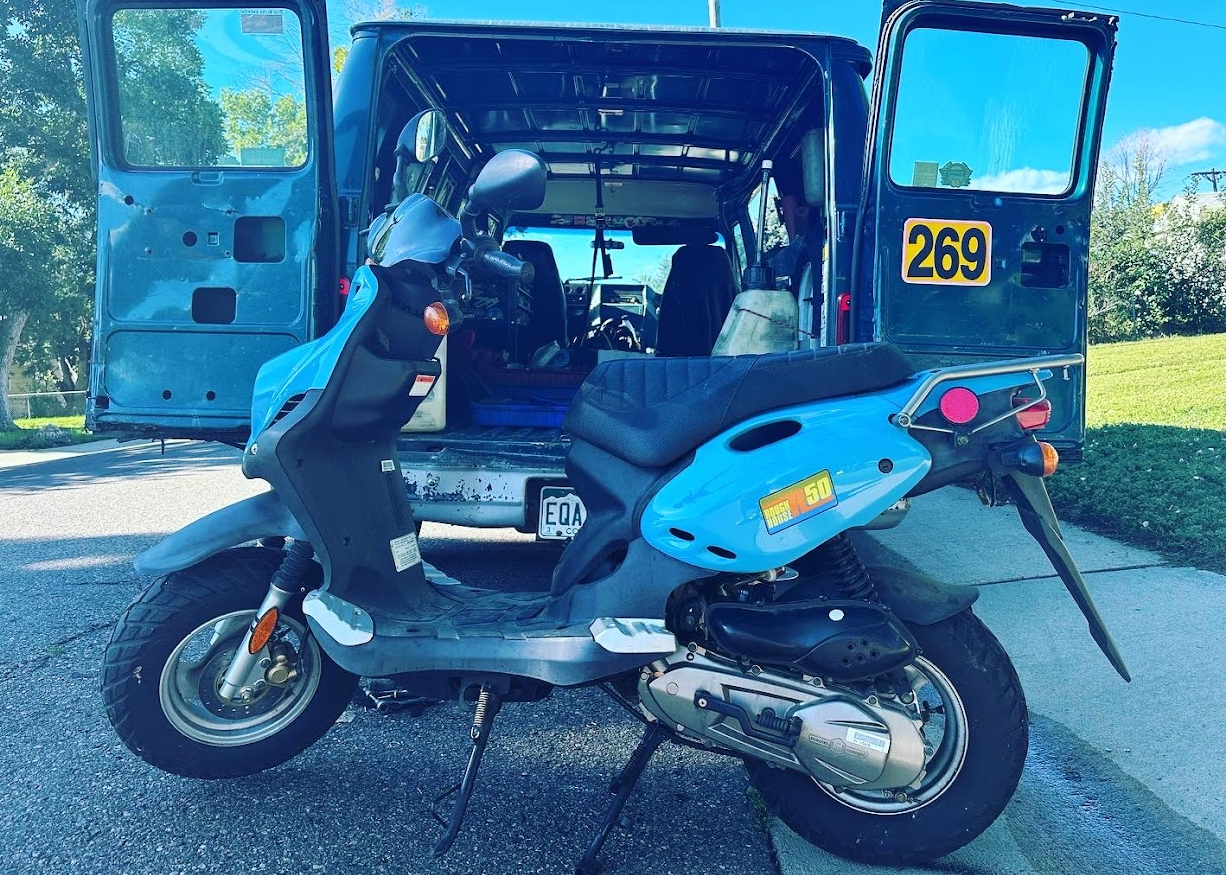
These aren’t as common as Honda Metropolitans and Ruckuses, but I work on them often enough. It’s called a Rough House, made by Genuine Scooter company, who sells a lot of re-badged PGO scooters here in the USA. It uses a 2-stroke engine based on the venerable Minarelli horizontal. It usually just takes a carb clean, air filter cleaning, and a spark plug to make these go again but watch out for crunchy crank seals and broken petcocks if you’re trying to fix your own. It’s about the same thing as a Genuine Buddy 50cc but with larger tires: same engine, slightly different chassis and bodywork.
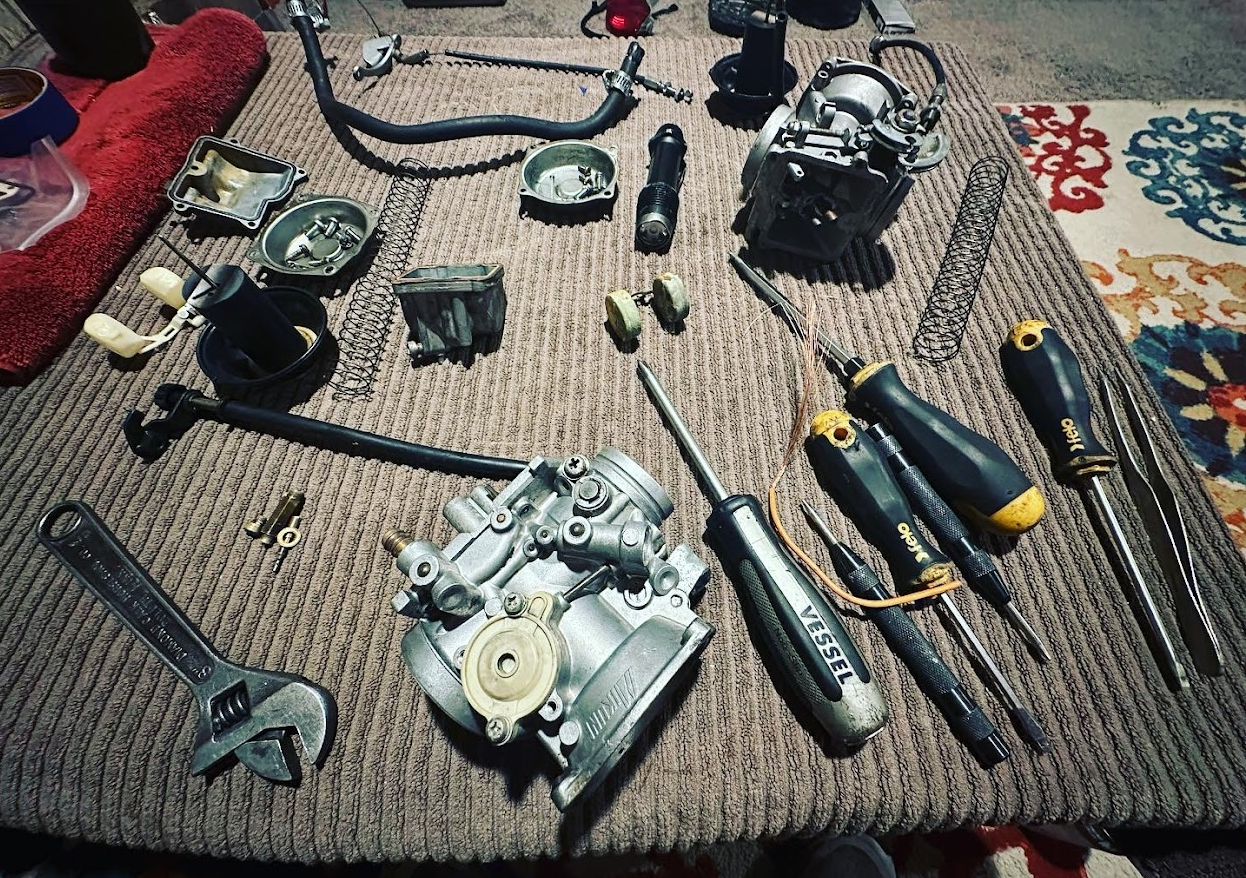
I do a lot of carburetor rebuilds on metric cruisers like the Suzuki Intruder, Honda Shadow, Yamaha V-Star, and Kawasaki Vulcan. This is a set of Suzuki Intruder carbs someone made a mess of, that has taken quite a while to locate all of the necessary parts they either broke or left off of the bike. I often use towels as a work surface because it allows me to set things like screws down without them rolling onto the floor, where they can become difficult to locate.
Impaktech Crash Cage Install on a ’23 Kawasaki Ninja 400
As an enthusiast and fancier of structures made of steel and aluminum tubing, I can appreciate the construction and build quality of this product. Crash cages are often installed on bikes the rider intends to stunt. Stunting is another form of motorcycle exhibition and competition, and it’s worth checking out on YouTube if you’ve never seen someone do it before. It’s kind of like skateboarding but on 2 wheels with an engine between your knees.

This customer didn’t want to stunt (yet!), she wanted something to hopefully protect her bike if she dropped it. It also looks pretty cool, and I’m thinking other riders are going to talk to her about stunting more often when they see her bike, and that might inspire her to get into that particular motorcycling discipline, which would be a very cool thing! A disproportionate number of my customers are women and LGBTQ* people, which kind of flies in the face of what a lot of straight dudebros tend to think about motorcycles, which is that they’re ridden exclusively by straight manly-man dudes. I enjoy disabusing dudes of this notion whenever I get the chance. Look up Kayla Yaakov if you want an example of a young woman who is not just giving the boys a run of their money but kicking their asses regularly at race tracks all over the world.

You can find more information about crash cages on Impaktech’s website. If the idea of taking a hole-saw to your bike’s fairings freaks you out, and you need one of these installed on your bike in Colorado Springs or Denver, go ahead and book online or give me a call or shoot me a text at (720) 634-6935.
Street Miles on My Personal ZX7R
I don’t exclusively ride motorcycles on race tracks. I also have what I consider one of the most brilliant old sport bikes ever made, that I ride somewhat infrequently on the street, mostly on Sunday mornings by myself. I got a chance to put about 50 miles on my ’02 Kawasaki ZX7R recently. What a lovely motorbike this thing is!
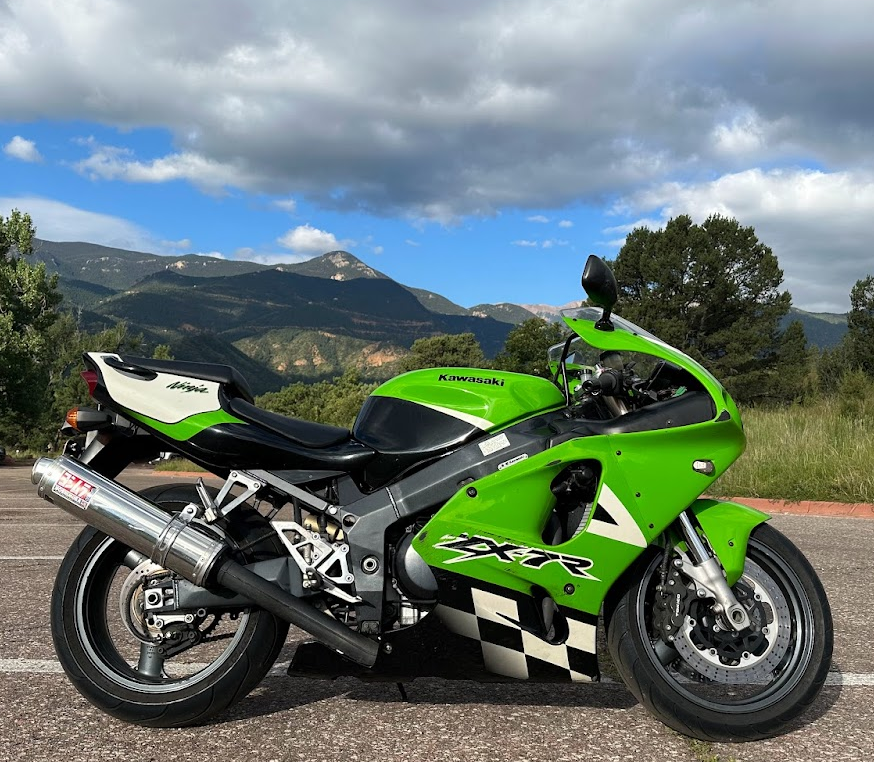
Recent work included flushing out the cooling system and replacing the thermostat and thermostat housing. The thermostat housing is still available from Kawasaki, though it is not cheap at about $160 for a piece of plastic that easily fits in my palm. The big things I had to address to get it running again were rebuilding the carburetors with all new o-rings, a much-needed valve adjustment, installing a new front tire, and reassembling it.
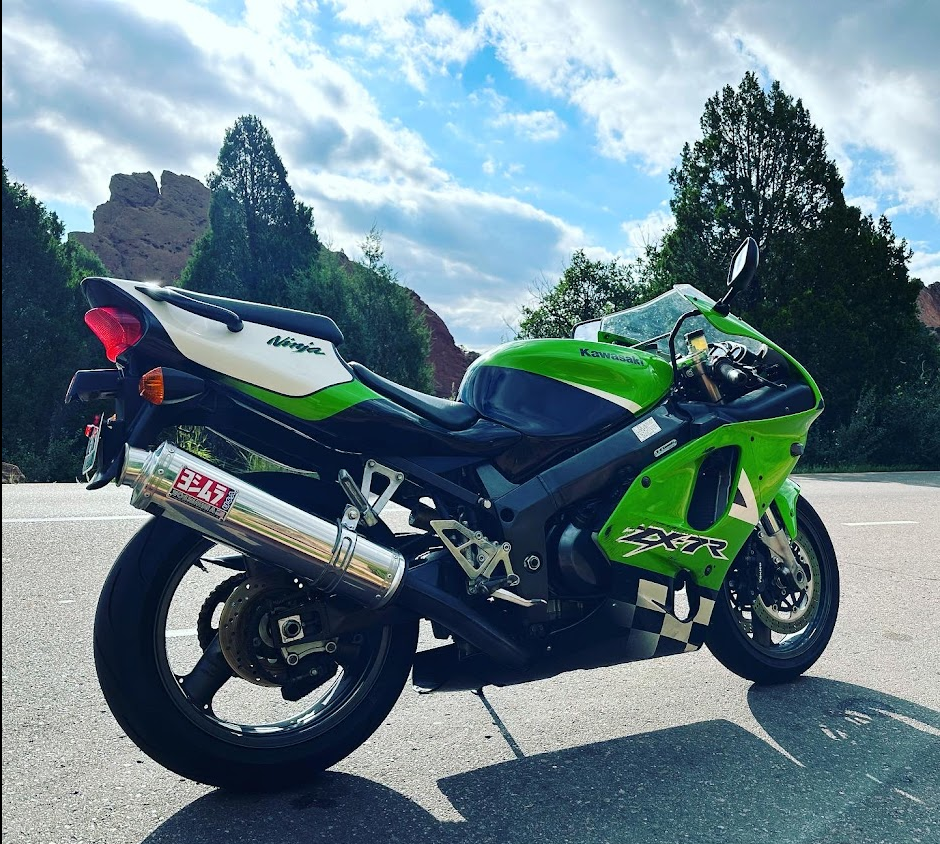
This is its “bad side”, the other side doesn’t have scraped up graphics. I’m guessing it has a Yoshimura can on it because the stock unit was destroyed when one of its previous owners dropped it on its side at speed. As a sport bike, it was outdated shortly after its release, but good looks and a reputation for reliability allowed it to soldier on as a new model into the early 00s. It is the quintessential “90s sport bike” and I’m stoked on how it runs, how it looks, the fact it’s mine, and I get to take care of it and ride it. Yes it’s a heavy motorcycle, but it goes where I point it, and it’s rock solid stable even at triple digit speeds.
If you own one of these and need help with it, or hell even if you just want to tell me about yours or see if I know where you can find the parts you need, feel free to give me a call at (720) 634-6935. I would love to meet more people in Colorado who own and ride ZX7s.
MRA Round 4 + 4-Hour Endurance @ High Plains Raceway
Initially I wasn’t going to participate in Saturday’s 4-hour endurance event, but the opportunity to join a team presented itself during the week before, so I got my buddy Matt into it as part of our team, too. Called “Team 4 in The Pink” because 3 out of 4 us were on pink and green bikes. Like minds think alike! Matt was forced to add some pink vinyl to his Yamaha R7 in order to conform to team requirements. It was either that or wear a tutu, and he wasn’t into that. Our only goal was to not finish last. We finished second to last! It was a hectic event, and I don’t have any pics of our team. HUGE THANKS TO LISA FOR GETTING US BOYS ORGANIZED!!
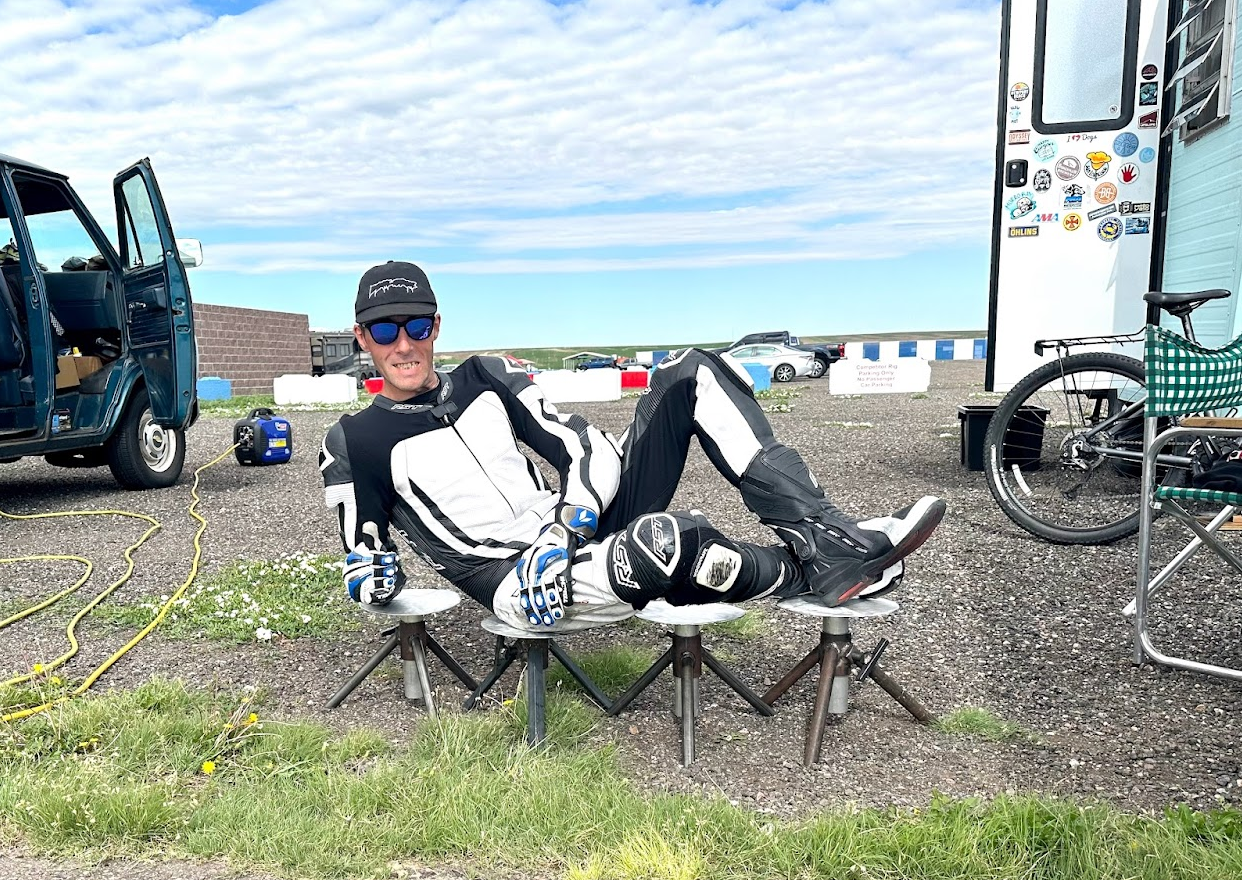
Going fast is only a part of racing; it’s not the whole shebang. There’s so much that goes into it that if you’re fast, that’s great. But if you’re not, you’re still enjoying the sport for the preparation and thought involved in putting a bike on the grid and the atmosphere that being at the races creates. Everyone gets faster at their own pace, and you can learn a lot about yourself in the pursuit of faster lap times regardless of how fast yours are compared to other racers. I think we should always grade other club racers on a curve starting with the fact that they showed up regardless of how fast they go that day.
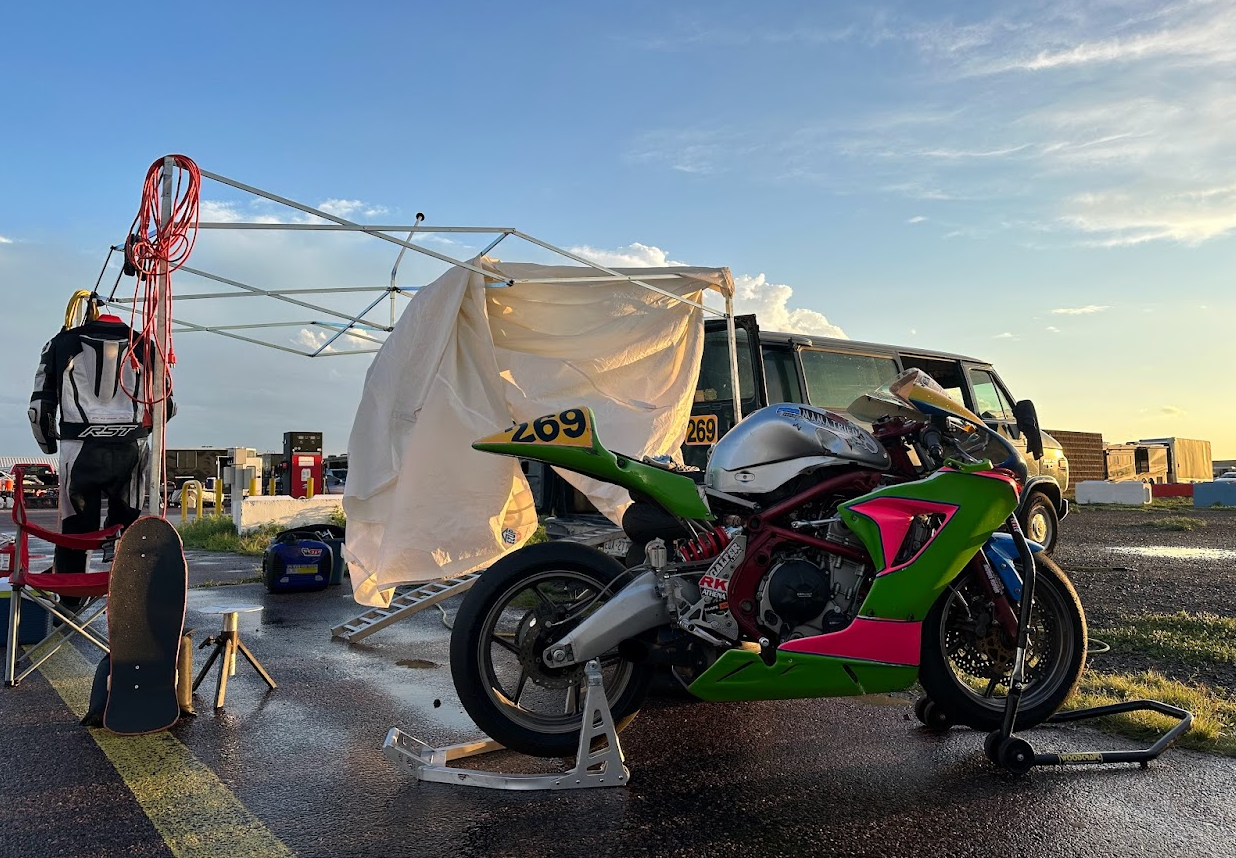
About an hour and a half into the endurance event the race was red flagged, everyone got pulled into the pavilion, and we were told the race was being called due to imminent hail and high winds. A mad dash followed with everyone trying their best to get their equipment to a safe place. I turned my air mattress in the van sideways, threw my bike inside, and stuffed everything else I didn’t want getting wet into the van, too. Everything did fine other than my canopy. That got bent up a little bit, but I bent it back and used it at Pueblo for the next round.
Things went better Sunday. Weather was nice. Bright, sunny, hot. I managed a personal best at HPR full course, a 2:04.951 lap during the SuperTwins GTU race. It’s going to be a sad day when I stop getting faster. I’ve managed to go faster and faster at every round I’ve entered since I started racing. My plan is to seek out coaching once I’ve exhausted all of my natural talent and ability to think about what I’m doing all by myself. Here’s a screen shot of that lap time. Images like this mean a lot to me, so I save them in case they get lost in some stupid database somewhere.

MRA Round 5 @ Pueblo Motorsports Park
This was a ridiculously fun event and a real testament to the power of going into things with low expectations. My expectation was to run somewhere in the 1:48s with :47s or maybe :46s in the cards, to have a good time, to maybe podium a race if it was somewhat lightly contested or enough Aprilias blew up in the heat. I told myself I didn’t really care about my times at Pueblo.
The first major thing to happen was yet another generic, eBay-sourced water pump seal decided to break in half as I was warming the bike up for my first practice session on Friday. I replaced it with an OEM seal from the Kawasaki dealership on the spot. It was the second time I had to replace these seals this year. There’s something to be said for being prepared in racing. It’s like going to war. I’d rather have things and not need them than need them and not have them, so I have a lot of spare parts for my bike on hand at the races. I tried to list all of my spares in a response to a Facebook post earlier this year, and it got so ridiculous that I deleted what I’d written without posting it. My advice to anyone wondering about race spares is to buy and bring everything you can afford and have space to carry, including a whole spare bike if you can swing it.
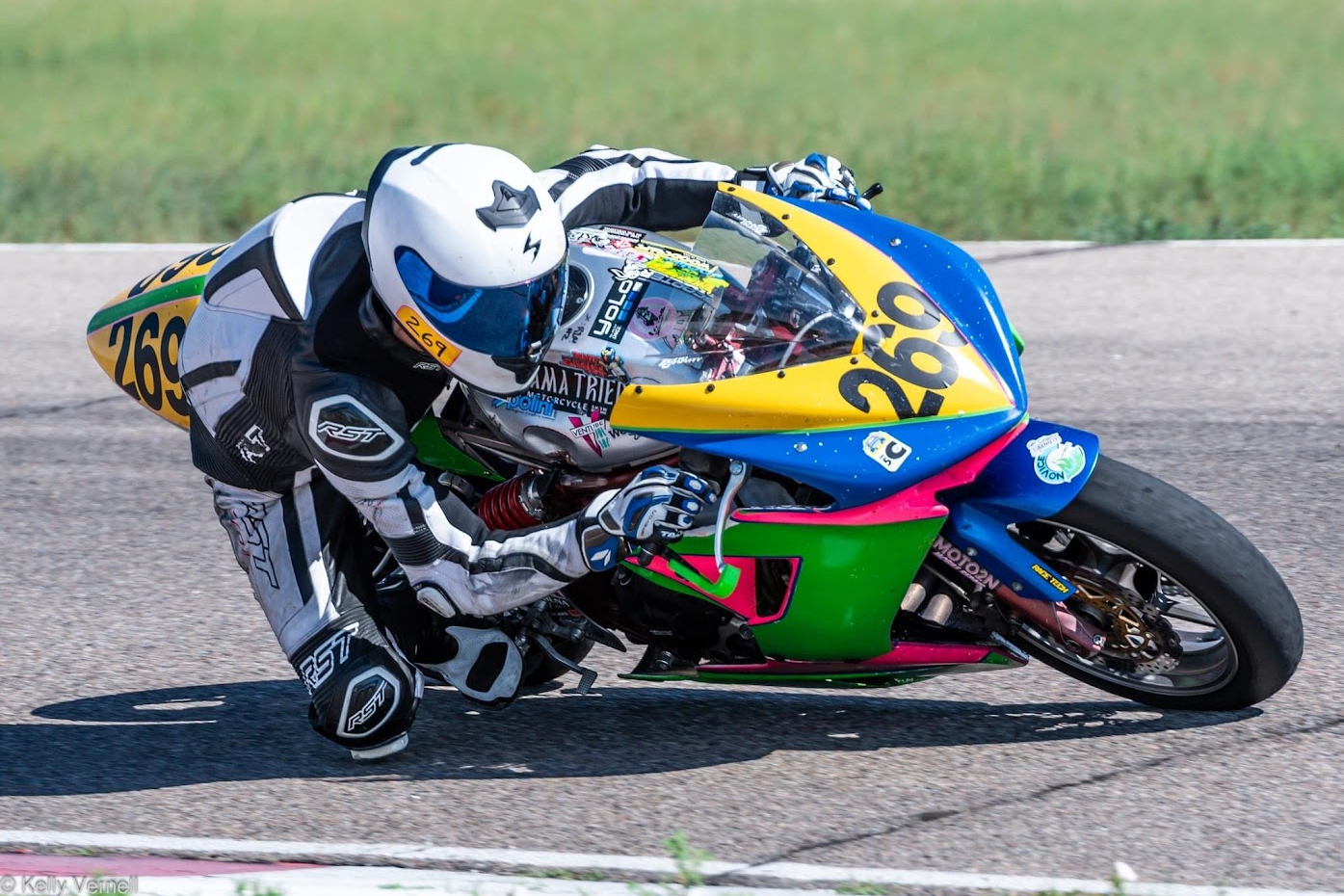
I ended up running the bike deep into the 1:45s, which is faster than I ever expected to run. My times would were fast enough to run with the fastest racers in the leading group at last year’s Pueblo race. I felt fast. I stayed in front of and made a lot of meaningful passes against racers that were faster than me last year and earlier this year. I podiumed 2 races and took a 4th in another race with a lot more racers participating, netting myself a heap of championship points I need to finish well come the end of the season. By Sunday I was feeling froggy and started pushing it in certain places, and things got sketchy fast. I lofted the rear of the bike coming into T7 and scared the bejesus out of myself.
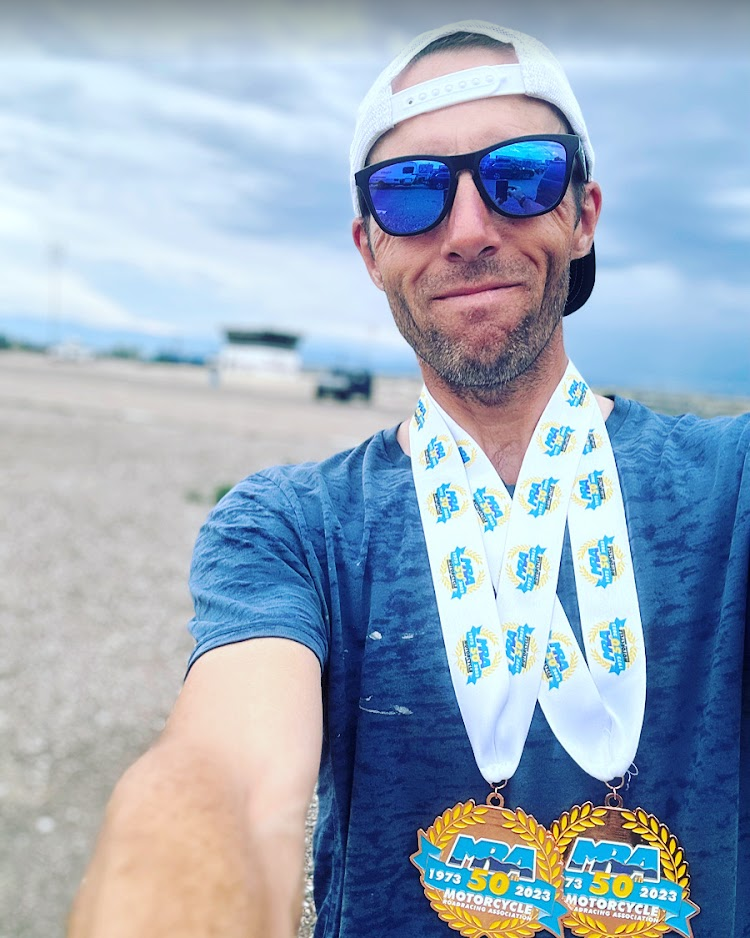
I also learned how to baby the bike when it started getting too hot. It was 100 degrees out, and my bike was getting really hot at the end of the straight, so I started shifting it early to keep the temps down. Surprisingly this only raised my lap times by about a second or so, which is a real testament to how fast you can go without throwing every last bit of power you have at the tarmac.
Huge thanks to everyone involved in making these events happen: the MRA board, safety team, PMP staff – John is always super fun to talk to, and the woman who works the gate is a character! And congrats to everyone who participated! It takes a lot to spend your money and show up to do something we’re all insanely passionate about, that means nothing to pretty much everyone else on earth, that’s difficult or impossible to try to explain to friends and family. We’re the only people who really get why we do this, and in my opinion it’s hard to explain in words. I’ve tried, but I always feel like I miss the mark.
Anyway that’s all for now. I’m posting this about 2 weeks away from Round 6, and I’ll try to get some posts up about other subjects between now and then. THANKS FOR READING!!! If you have a bike you’re thinking about getting fixed, please book online or give me a call or text me at (720) 634-6935.